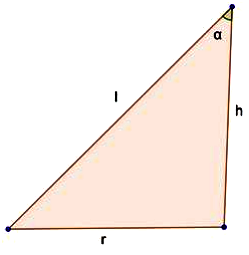
Let ‘r’ be the radius of the base circle of the cone and ‘l’ be the slant length and ‘h’ be the height of the cone :
Let us assume ‘α’ be the semi - vertical angle of the cone.
We know that Volume of a right circular cone is given by :
⇒ V = \(\frac{\pi r^2h}{3}\)
Let us assume r2h = k(constant) …… (1)
⇒ V = \(\frac{\pi k}{3}\)
⇒ h = \(\frac{k}{r^2}\) ...(2)
We know that surface area of a cone is,
⇒ S = πrl …… (3)
From the cross - section of cone we see that,
⇒ I2 = r2 + h2 ...(4)
Substituting (4) in (3), we get
⇒ S = πr(\(\sqrt{(r^2+h^2)}\)
From (2),

Let us consider S as a function of R and We find the value of ‘r’ for its extremum,
Differentiating S w.r.t r we get,
⇒ \(\frac{dS}{dr}\) = \(\frac{d}{dr}(\frac{\pi\sqrt{r^6+k^2}}{r})\)
Differentiating using U/V rule,

Equating the differentiate to zero to get the relation between h and r.

Since the remainder is greater than zero only the remainder gets equal to zero
⇒ 2r6 = k2
From(1)
⇒ 2r6 = (r2h)2
⇒ 2r6 = r4h2
⇒ 2r2 = h2
Since height and radius cannot be negative,
⇒ h = \(\sqrt2\)r …… (5)
From the figure,
⇒ cot α = \(\frac{h}{r}\)
From(5)
⇒ cot α = \(\sqrt2\)
⇒ α = cot-1\(\sqrt2\)
∴ Thus proved.